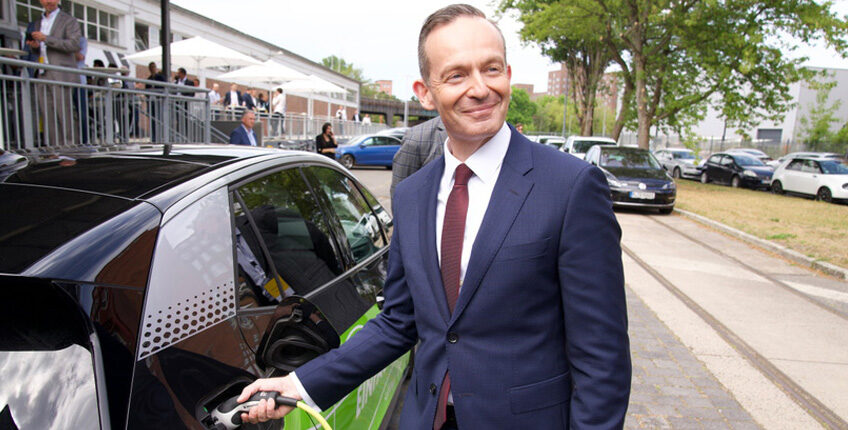The German federal government has developed the new ‘Charging infrastructure II masterplan’ as a roadmap for the expansion of charging infrastructure for the government and other expansion actors. Now available, the masterplan draft was prepared by the Federal Ministry for Digital and Transport (BMDV) and will now be sent to the relevant stakeholders such as federal states, municipalities, associations and companies, in order to discuss the various measures with them as a next step.
The federal government is committed to the electric mobility goals outlined in the coalition agreement. Germany is to become the lead market globally for e-mobility with one million publicly accessible charging points. This requires the advance expansion of a nationwide, needs-based and user-friendly charging infrastructure. The charging infrastructure masterplan represents the overall strategy developed by the federal government for this purpose. It is oriented towards user needs and also includes charging infrastructure for heavy battery-electric commercial vehicles. Measures contained in the masterplan will make the construction and operation of charging infrastructure easier, more convenient and faster. At the same time, the appeal of charging infrastructure as a business model will be increased, thus mobilizing greater investment from the private sector.
Dr. Volker Wissing, Federal Minister for Digital and Transport: “From our perspective, the charging infrastructure II masterplan is a key element in the continued ramp-up of electric mobility. It helps us reach the point where people can just as easily charge their e-vehicle as they have previously refuelled their car. The masterplan therefore dramatically accelerates the expansion of charging infrastructure. Both climate protection as well as users of electric cars in Germany will significantly benefit from the measures contained in the masterplan. It sets the pace for federal government activities. It provides us with a future-oriented basis upon which the accelerated charging infrastructure expansion for cars and trucks can succeed together with states, municipalities and industry.”
The National Centre for Charging Infrastructure, under the umbrella of federally-owned NOW GmbH, supports the BMDV in developing, coordinating and implementing Masterplan II. The acceleration of authorization procedures, integration of the charging infrastructure into the power grid, digitalization of the charging experience and many other challenges are tasks that will be taken on as a matter of urgency. Only together with all key players will it be possible for an advance expansion of a national, needs-based and user-friendly charging infrastructure to succeed.
Here is an overview of the most important measures in the charging infrastructure masterplan II draft:
- The federal government is establishing an interministerial steering group for charging infrastructure (ISLa) to ensure the implementation of the masterplan’s measures. Stakeholders carrying out the implementation from the private sector as well as federal states and municipalities are to be closely involved in the process.
- All measures will be underpinned by a needs analysis. Among others, this will be based on the National Centre for Charging Infrastructure’s planning instrument: StandortTOOL, as well as empirically-based prognoses on the back of discussions with industry in compliance with antitrust law.
- Based on the evaluation of the funding programmes thus far, the BMDV will draw up a concept for efficient, targeted and rapid financial support for the expansion of the charging infrastructure by early 2023.
- The development of public charging infrastructure in the municipalities plays a key role. The federal government is therefore examining up to the end of 2022, how a legal obligation on states can be implemented to guarantee basic supply to local charging infrastructure. At the same time, the municipalities will be supported via a comprehensive package of measures for planning, implementation and financing.
- To mobilise other land, the federal government, states and the municipalities are examining their own land and properties with respect to potential construction of charging infrastructure.
The federal government is developing a digitalization roadmap in 2023. It will show what digitalization steps need to be taken to make an overall charging infrastructure that appeals to users. - The expansion of charging infrastructure and power grids must be better coordinated. To ensure the speedier expansion of charging infrastructure, better interaction between the power grid and electric mobility is to be conducted efficiently and with an eye to the future by all players involved, including local authorities, grid operators and those seeking connections.
- A range of legal measures aims to simplify the construction of charging infrastructure and make its use more appealing in everyday life. Issues involved here include how night charging on supermarket carparks can have a solid legal basis and how installation in buildings can be made easier.
- E-trucks will play a key role in significantly reducing carbon emissions in road freight transport as well. They need specific charging infrastructure with particularly high charging capacities. To ensure an early start to its construction, the BMDV will issue a call for tenders for the construction of an initial charging network from 2023.
- To be able to recognise adaptation requirements early on, all measures will be continually recorded in a monitoring system.


